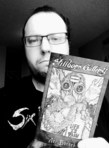Axl Barnes's Blog, page 5
May 19, 2020
My Pyramid of Books
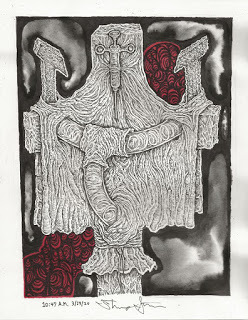 Exit mask #3 by
Foul Apparatus
Exit mask #3 by
Foul Apparatus
Bury me inside my pyramid of books,the books I own, the ones I touched,the ones I forgot, and the ones I wanted but never got to open. Cover my tomb with my skin and tattoo on it the poems I wrote,and the ones I never got to write.Anoint my fortress with my blood. When it rains, inky water will drip on my bleached bones,and it will make me remember all my celluloid dreams,both black and white and colored.The old pages of my tomb will flutter in the dusty wind, and letters will blow haphazardly and whisper new stories,new languages, new questions.Thus, the wind and the rain will form an umbilical cord,a coiled adder,between my grave and my restless silence.
Published on May 19, 2020 14:48
March 11, 2020
The Cheerful Nihilist (On Ligotti's The Conspiracy Against The Human Race)
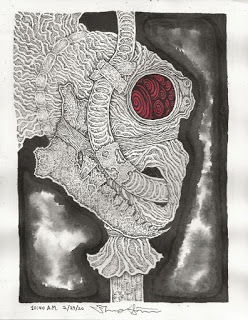 Exit Mask #1, by Foul Apparatus From the first pages of Thomas Ligotti's The Conspiracy Against The Human Race, I knew this author will have his place among my spiritual masters, alongside Nietzsche, Cioran, Camus or Heidegger. This is a book I'll come back to again and again, as it reignited a private argument which will only end when I crumble under dementia or am six feet under. Besides the philosophical content, one of the most original aspects of this work is the synthesis between philosophical pessimism and supernatural horror. As both philosopher and horror writer, Ligotti is able to draw connections between abstract ideas and the concrete stuff that scares us in horrors: creepy dolls, clowns from outer space, unknown monsters of the deep sea, The Old Ones, decrepit mansions, and so on.
Exit Mask #1, by Foul Apparatus From the first pages of Thomas Ligotti's The Conspiracy Against The Human Race, I knew this author will have his place among my spiritual masters, alongside Nietzsche, Cioran, Camus or Heidegger. This is a book I'll come back to again and again, as it reignited a private argument which will only end when I crumble under dementia or am six feet under. Besides the philosophical content, one of the most original aspects of this work is the synthesis between philosophical pessimism and supernatural horror. As both philosopher and horror writer, Ligotti is able to draw connections between abstract ideas and the concrete stuff that scares us in horrors: creepy dolls, clowns from outer space, unknown monsters of the deep sea, The Old Ones, decrepit mansions, and so on.Ligotti draws the distinction between optimists and pessimists about life. Pessimists think that the existence of the human race is a tragic anomaly and that being alive is mostly meaningless suffering. The evolution of consciousness is a terrible accident as it amplifies our torment, making us aware of our own mortality and the fact that we're basically meat in a meat-grinder. The universe is a cold, dark place where no one can hear our screams and our horizon is smeared with blood. For the pessimist, the faster this nightmare existence ends, the better it is for everyone, and we should lament every birth as a violation of blissful nonexistence. By contrast, for the optimist being alive is all right; he has no major complaints as he's likely under the spell of a grand narrative featuring God, Family, Nation or The Good, a fabrication that infuses his life with hope and meaning. For the optimist, consciousness is a wonderful thing as it allows us to know the world and gives us the power to plan and change it for the better. On his view, the human race is special and noble, it rises above the rest of creation as man alone was awarded the power of consciousness, and the freedom and responsibility that come with it.
Following Norwegian philosopher Peter Zapffe, Ligotti argues that optimists manage to stay optimistic because they're able to minimize their consciousness and zombify themselves. This trick can be achieved in four ways: isolation, anchoring, distraction, and sublimation. On Ligotti's view, these four methods constitute what he calls "the conspiracy against the human race," in the sense that by this process of more or less conscious self-deception we avoid facing the pointless cosmic butchery we're trapped in, and thus we miss our only salvation, which is our outright extinction as freaks of nature.
When we use the first method, "we isolate the dire facts of being alive by relegating them to a remote compartment of our minds. They are the lunatic family members in the attic whose existence we deny in a conspiracy of silence." According to the second method, in order to "stabilize our lives in the tempestuous waters of chaos, we conspire to anchor them in metaphysical and institutional "verities"—God, Morality, Natural Law, Country, Family—that inebriate us with a sense of being official, authentic, and safe in our beds." The third method aims at turning a blind eye to cosmic horror by "distractingour minds with a world of trifling or momentous trash. The most operant method for furthering the conspiracy, it is in continuous employ and demands only that people keep their eyes on the ball—or their television sets, their government's foreign policy, their science projects, their careers, their place in society and the universe, etc. The final method consists of us sublimating "our fears by making an open display of them. In the Zapffean sense, sublimation is the rarest technique utilized for conspiring against the human race. Putting into play both deviousness and skill, this is what thinkers and artistic types do when they recycle the most demoralizing and unnerving aspects of life as works in which the worst fortunes of humanity are presented in a stylized and removed manner as entertainment. In so many words, these thinkers and artistic types confect products that provide an escape from our suffering by a bogus simulation of it—a tragic drama or philosophical woolgathering, for instance."
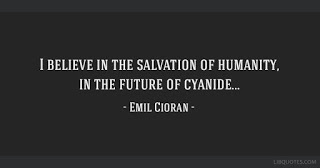
Ligotti's main message is not news to me, since I've been an Emil Cioran (whom Ligotti calls "a maestro of pessimism") fan since the tender age of thirteen. Furthermore, I'm deep into existentialism, have a couple of grim horror books of my own , and am also into Depressive Suicidal Black Metal, a subgenre of Black Metal aimed at conveying feelings of alienation, loneliness, despair, and at reminding people that suicide isn't such a bad idea. However, Ligotti's passionate and clear arguments, his beautiful and honest style, and the graphic way he portrays our sorry existence has made me revisit my stance on these core existential issues. I have two interrelated critical comments on Ligotti's book, after a first reading. The first one concerns the psychological type of the cheerful nihilist, and the second one describes one of the main challenges for the pessimist, the challenge of being a nobody.
First, I and many others I would imagine, don't consider ourselves either pessimists or optimists, but are cheerful nihilists. Being a true pessimist is pretty hard. In The Trouble with Being Born, Cioran claims "I do nothing, granted. But I see the hours go by—which is better than trying to fill them." Cioran here refers to the excess of lucidity the pessimist endures, which, however, brings him closer to the ugly truth of life, and he proclaims this to be better than being a busy self-deluded puppet invested in killing time. Be that as it may, not many people are inclined to just sit around and see the hours go by. Eventually, they'll start doing something. Off themselves? Maybe. But the "maestro of pessimism" is quick to point out: "Only optimists commit suicide, optimists who no longer succeed at being optimists. The others, having no reason to live, why would they have any to die?" So, do what then? Camus' point in The Myth of Sisyphus is that the absurdity of the universe, in and of itself, has no bearing on how we should live our lives. Whatever we do is of no consequence in the big picture. Now, some might find this depressing and just decide to see the hours go by and wallow in self-pity. But the cheerful nihilist sees this grim state of affairs as pretty liberating. The universe is a playground where you can do whatever, as there are no parents in sight (or gods). The world is an amusement park and why not have some fun before surrendering to infinite darkness? The cheerful nihilist is neither a pessimist nor an optimist, he's mostly agnostic and non-committal. While he's aware that consciousness amplifies suffering, he also knows that it makes possible higher pleasures, like reading and writing books, which even Cioran himself has indulged in most of his life, when sick of watching the hours go by. So, the cheerful nihilist is not prone to any extreme views as the total eradication of humankind. Also, his commitment to life doesn't involve the delusions the cowardly optimist clings to. The cheerful nihilist is not fully anchored in any values and keeps a critical, ironic distance toward any grand narratives with a happy ending. He is, after all, a student of postmodernism. The cheerful nihilist might engage in sublimation for the fun of it, not with the heroic, virginal fervor of someone like Nietzsche, but with more restrained enthusiasm. The cheerful nihilist floats in a universe of scepticism, uncertainty, and irony, but, despite his awareness of the ugly truths behind the scenes of daily life, he's trying to enjoy what existence has to offer till sickness and the Grim Ripper make their necessary appearance.
Second, I think being a true, fully consistent pessimist is not only hard but almost impossible. It's really a tough position to hold, without appearing hypocritical. Martin Heidegger has argued that human beings, as beings-in-the-world, exist mostly in a state of inauthenticity. That is, simply put, they do what others do, what They do, what is done. We mostly live in the inauthentic human soup of The They, we do what's expected of us in a zombie-like fashion. We keep busy, plan for the future, always ahead of ourselves, absorbed by some job or another. This goes on, Heidegger argues, until our awareness of our own death hits us and our knees buckle. No one else can die in our place, we face death alone. This gives us anxiety, and only in this state of fear of death do we become authentic, because death forces us to see our lives as our own, and no one else's. However, Heidegger argues, humans don't linger in this state of anxiety for long. Eventually, they reach a decision about the trajectory of their lives and then succumb again, willy-nilly, to the force of The They. The They is our home. Authenticity is just a bad trip we normally forget about. Now, the options of what to do with our lives are provided on the public market as predefined social roles. Tired of your job? Go back to school. A recent injury doesn't allow you to have a career in hockey? Try an office job. You don't know what degree to aim for? Try traveling around the world to find yourself. It follows that, like most of us, the pessimist cannot sustain the state of anxiety for long. Eventually, he'll submit to the power of The They and just live like others do. Like in the case of Cioran, he gave up on watching the hours go by and became a famous writer. He was also a voracious reader. In the same vein, Ligotti points out Lovecraft's interest in architecture. Schopenhauer was a monarchist and professional Hegel hater. My point is that despite the dramatic posturing, most pessimists are just like the rest of us, subject to the force of The They, they live like most of us, enjoying some things, hating others. And if they de facto take part in this inauthentic communal life, then what right do they have to say life is no good? Isn't that a bit hypocritical? Like some emo youth with a Nocturnal Depression t-shirt shopping in the organic section and complaining about the poor selection or an antinatalist trying to become a nurse. This schizoid Dr. Strangelove-type appearance is not a good look for the pessimist. It raises doubts and questions. Moreover, pessimists can't kill themselves either because only optimists kill themselves. Suppose then that they decide to live like pariahs, losers, at the margins of society? After all, Cioran famously claimed: "Only one thing matters: learning to be the loser." However, this, on the face of it, is a project, something to strive for. Like being the town drunk, being the loser is a social role, still in the social space of The They, though, admittedly, on the margins of that space. Cioran was well-aware of this challenge the true pessimist faces, which is one of the reasons he turned down a handful of prestigious literary awards claiming that one cannot write a book like The Trouble With Being Born only so one can cash a literary prize.
Ligotti is aware of the power of the survival instinct and how it can blindside us even if consciously and intellectually we want to reject it. Then, given that humans, like all animals, are hardwired to be social, maybe it's best to look for the authentic pessimist in the ranks of the mentally ill, those malfunctioning brains that make installing the sociability program almost impossible. In this respect, Ligotti's description of depression is telling:
"This is the great lesson the depressive learns: nothing in the world is inherently compelling. Whatever may be really "out there" cannot project itself as an affective experience. It is all a vacuous affair with only a chemical prestige. Nothing is either good or bad, desirable or undesirable, or anything else except that it is made so by laboratories inside us producing the emotions on which we live. And to live on our emotions is to live arbitrarily, inaccurately—imparting meaning to what has none of its own. Yet what other way is there to live. Without the ever-clanking machinery of emotion, everything would come to a standstill. There would be nothing to do, nowhere to go, nothing to be, and no one to know. The alternatives are clear: to live falsely as pawns of affect, or to live factually as depressives, or as individuals who know what is known to the depressive. How advantageous that we are not coerced into choosing one or the other, neither choice being excellent. One look at human existence is proof enough that our species will not be released from the stronghold of emotionalism that anchors it into hallucinations. That may be no way to live, but to opt for depression would be to opt out of existence as we consciously know it."Thus, the depressive would be a good candidate for an authentic pessimist. From a Heideggerian perspective, a depressive is no longer a being-in-the-world. He's a puppet with its strings cut off, an existential abortion. As Ligotti puts it, depressives need not "apply for a position in the enterprise of life." There's a gaping abyss between the depressive and the world, a darkness that strips him of the luxury of an identity or a sense of will. For the depressive, saying or thinking "I" is nothing short of a miracle. There's usually telltale signs of depression, so that even when a depressive decides to participate in the enterprise of life, they give themselves away easily. They're awkward and out of synch with the others, they either talk too much or are too quiet, they laugh too hard as if to keep the inner darkness at bay and reassure themselves that they're really succeeding at playing the game of life like all the others, and that the game is real. However, deep down, they know that the trick won't work and the illusion will dissipate soon, like the makeup running down the face of an alien dressed as a clown. When it comes to parties or other social gatherings, the depressive either cancels at the last moment or leaves early as they feel they can't ignite their socializing engine. If the engine starts, the depressive is the last one to leave the party as he knows this is as good as it gets for him and the usual darkness patiently awaits at home. A few years ago I had this friend suffering from Borderline Personality Disorder. I've noticed that even when she'd take a stab at socializing, she would refuse to appear in group pictures. Later, she explained to me that she wants to live like a ghost. After she dies, she confessed, she wants people to wonder if she truly existed.
This notion of being a living ghost reminded me of John Darnton's brief portrayal of someone suffering from Cotard's syndrome in his book Mind Catcher, when his character, neurosurgeon Kate Willet, visits a psychiatric ward for severely mentally ill.
"The room was dimly lit and she could not see very well, but she didn't care to get a better view. There was one bed in the room and a young man supine on it. His wrists and ankles were tied to the sides of the bed with thick white straps, and he was lying totally stiff, as if he were a piece of wood. His eyes were open and staring straight up at the ceiling; they didn't move. Nor did he seem to blink. His skin was ashen gray. His shirt was off, and when Kate looked closely, she saw that his upper torso and his arms and his ankles and his face were covered with wounds—deep angry red gouges running in parallel lines. He had evidently inflicted them upon himself with his fingernails. The administrative assistant came up behind them. When she spoke, Kate almost jumped out of her skin."That is an unfortunate man," the woman said. "He has an extremely rare illness called Cotard's syndrome. [...] In this case, the patient has no emotions whatsoever. He's totally without affect. The patient is stripped of all signs of life. In fact, he becomes convinced that he is actually dead, and it is impossible to rid him of this particular delusion. At times he will smell his own flesh rotting. And at other times he becomes convinced that worms are crawling over his rotting corpse, and he scratches himself without ceasing. For that reason, he must from time to time be restrained."
To sum up, the authentic pessimist, as opposed to the emo poser, is most likely to be found in the ranks of those suffering from mental disorders. Unable to fully dissolve himself in the forgetfulness of the They, his surplus of consciousness giving rise to a chronic alienation, the true pessimist is a master of killing time, time is the enemy as each second takes him closer to inevitable death, and also because time is the reminder he already is dead, but not yet buried. As Cioran says, "A book is a suicide postponed," a suicide that will always come too late, as the true pessimist, being already dead, sees no point in final gestures or affirmations.
Like I said, these are just two of the multiple thoughts and ideas I've had while reading Ligotti's marvelous book The Conspiracy Against The Human Race. His incisive style, clear argumentation, beautiful prose, and grim imagery will make me come back to his book and read his fiction work as well. As a cheerful nihilist, I hope Ligotti's dark fiction is delightful and that my ability to enjoy good books lasts for many years to come.
Published on March 11, 2020 13:25
January 17, 2020
January 1, 2020
The Writing Dead
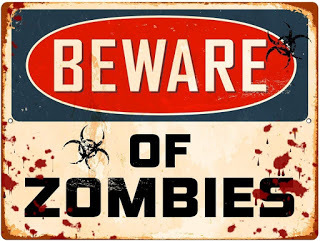 Beware, the dead are writing! They happened on a new way to trap us and eat our brains: zombie writing. As it's to be expected the writing of the undead is boring and foggy, impersonal and vague, tinged with unfocused nostalgia for real life. However, that writing has the terrible power to induce sleep and leave one defenseless in the face of a zombie attack It's crucial for our survival to be able to distinguish zombie writing from real writing. For that, we need to go back to the source of authentic writing and tattoo on our still-functioning brains the words of a master about his craft. I speak, of course, of Emil Cioran, Nietzsche's most significant disciple.
Beware, the dead are writing! They happened on a new way to trap us and eat our brains: zombie writing. As it's to be expected the writing of the undead is boring and foggy, impersonal and vague, tinged with unfocused nostalgia for real life. However, that writing has the terrible power to induce sleep and leave one defenseless in the face of a zombie attack It's crucial for our survival to be able to distinguish zombie writing from real writing. For that, we need to go back to the source of authentic writing and tattoo on our still-functioning brains the words of a master about his craft. I speak, of course, of Emil Cioran, Nietzsche's most significant disciple. “A book is a suicide postponed,” Cioran reminds us. “Write books only if you are going to say in them the things you would never dare confide to anyone.” "True confessions are written with tears only. But my tears would drown the world, as my inner fire would reduce it to ashes" "I like thought which preserves a whiff of flesh and blood, and I prefer a thousand times an idea rising from sexual tension or nervous depression to empty abstraction."
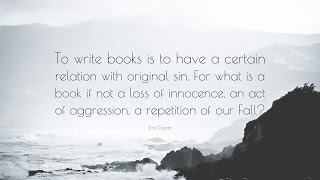
Now we have the litmus test for zombie writing. The dead don't commit suicide, being already dead and all, and therefore they can't postpone their suicide. The undead have no confessions to make and no tears to shed. The dead don't hurt, they have no emotions, no sex drive, no melancholy, they just want to feed on flesh and brains. The dead don't bleed either. If you cut the words of zombie writing with a knife, the wound doesn't bleed, no tears come out, but only the pungent stench of busy locker-rooms, the boiling pus of repressed nightmares, and the white sand of boredom.
Zombie writing is a serious threat to our survival as a species. Zombies write for money, the living are their customers. The undead use money to produce more dead prose and gradually annihilate their hapless victims with their poisonous offerings. The larger the web the more flies get stuck in it. Why are the living paying for this junk? Well, for the same reason they buy heroin: sedation, abdication, the promise of decay hidden in a shot of Krokodyl, the thrill of forgetting. Being human, let's face it, is hard work. All these thoughts and emotions, this constant torment of lucidity, it can get pretty exhausting. And for what? There's no reward for being human. Most of us want out, whether we know it or not. We want to apply for bankruptcy, we instinctively know there's no winning here. The EXIT sign flashes red under our fragile web of mundane thoughts and empty gestures. We just want to die and shed our consciousness. We dream of the Paradise of mummification. We want to discard our existence like a filthy rag. We crave the bullet, the guillotine blade, the black sack over our heads before strangulation. We're eager to find our Jim Jones and ask for our promised cyanide. That's why we read about riding nonexistent dragons and setting nonexistent cities on fire, we fantasize about nonexistent castles and kings and Disney princes and princesses, we fancy ourselves superheroes to make up for the deeper, nagging knowledge that we're not fit for life.
I voice this warning about zombified art but it might be too late, the infection is spreading fast, the siren call of Death has turned into a totalitarian command. Besides the Edgetivist trend, no one seems to care about their lives. Human life is cheaper than during the Black Plague. On the positive side, I realize I have something in common with the undead, there's something to cannibalism. And I don't mean in Jeffrey Dahmer's sense, clean skin is probably just as disgusting to chew on as inked skin. But more in line with Emil Cioran's dictum: “Sometimes I wish I were a cannibal – less for the pleasure of eating someone than for the pleasure of vomiting him.”
Published on January 01, 2020 10:14
December 26, 2019
December 8, 2019
On Edgetivism
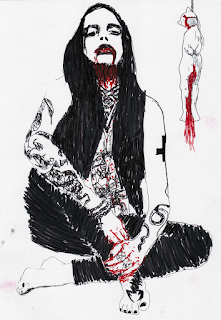 My Sister Before Her Suicide
My Sister Before Her SuicideWhile in the last post I gave a thumbs down to the degenerate Christian clique calling themselves The 'Satanic' Temple, in this post I give a thumbs up to the Edgetivist movement in art. Chaoscunt, the philosopher behind the movement, starts from the premise that art is not real life. The resulting behavior of a perceiver of a work of art is his own responsibility, not that of the artist. Art is just a virtual arena where we face our own demons, a realm of psychological exploration and experimentation. Chaoscunt warns of the danger of virtuestigmaism, the destructive trend "to categorize works of art by their most superficial aspects, notably 'political' associations." This leads to censorship and domestication of art, and the ascendance of saftyism, a wave of politically correct and safe works of art that by their nature are mediocre but highly praised by social justice warriors.
In reaction to this decadent trend in art, Chaoscunt advances Edgetivism,which is art with an activist dimension. The Edgetivist purposely explores the most taboo subjects in his society in order to remind everyone that art is not real life, thus re-establishing art as a realm of perfect freedom. The Edgetivist puts himself at risk and will be marginalized by the mainstream groups of castrated artists, but his mission is noble and heroic. "The Edgetivist will explore the most socially unacceptable aspects of life in his art. Not only does the work have to be breaking some sort of law that goes against freedom of artistic expression but also be reprehensible to the point of leaving 95% of society in shock. If you can put the contents of the work on a t-shirt and walk without getting into trouble with most people on the street, then it has failed to be edgetivist."
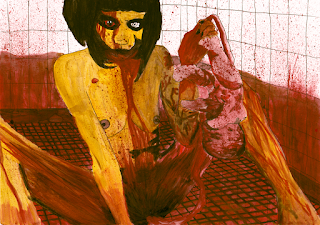 Christians Oppose Abortions Because They Like to Fuck Orphans I find myself in agreement with Chaoscunt's point that consumerism and political correctness can be very damaging to true art. There are many factors that contribute to the domestication of art once it's treated as a commodity meant to provide entertainment and 'an escape' from the drudgery of daily life. One thing I find particularly repulsive, connected with Chaoscunt's point about people's failure to distinguish art from the real world, is how people fail to distinguish the artist, as a real human being, from his art. If the artist isn't 'nice' they won't support his art. If the artist is personable and goes to talk shows and makes jokes and is humble, then they support his art. Examples abound. Black metal band Inquisition being dropped by Seasons of Mist once Dagon was found to be into child-porn. Yes, the guy has issues but he's a beautiful artist and the Inquisition sound will always stand out in the black metal landscape. That Roman Polansky is a rapist is not gonna stop me from enjoying Rosemary's Baby. That Varg Vikernes is a racist, murderer, and arsonist isn't gonna stop me from enjoying Burzum. There's a deeper issue here: the consumerist war against dangerous artists and dangerous art. Art has the special power of waking people up from their inauthentic slumber, like a chainsaw powered up next to your ear while you're in the middle of a sweet, wet dream. Terror and vertigo strike, suddenly you don't know who you are, where you are, and what's going on. But then when you see that very artist who rudely awoke you go to a talk show and smile and play nice so he can sell his merch, you see that they're slaves just like you, they're nothing special about them, and you let yourself dissolve in your dogmatic, comfy slumber again.
Christians Oppose Abortions Because They Like to Fuck Orphans I find myself in agreement with Chaoscunt's point that consumerism and political correctness can be very damaging to true art. There are many factors that contribute to the domestication of art once it's treated as a commodity meant to provide entertainment and 'an escape' from the drudgery of daily life. One thing I find particularly repulsive, connected with Chaoscunt's point about people's failure to distinguish art from the real world, is how people fail to distinguish the artist, as a real human being, from his art. If the artist isn't 'nice' they won't support his art. If the artist is personable and goes to talk shows and makes jokes and is humble, then they support his art. Examples abound. Black metal band Inquisition being dropped by Seasons of Mist once Dagon was found to be into child-porn. Yes, the guy has issues but he's a beautiful artist and the Inquisition sound will always stand out in the black metal landscape. That Roman Polansky is a rapist is not gonna stop me from enjoying Rosemary's Baby. That Varg Vikernes is a racist, murderer, and arsonist isn't gonna stop me from enjoying Burzum. There's a deeper issue here: the consumerist war against dangerous artists and dangerous art. Art has the special power of waking people up from their inauthentic slumber, like a chainsaw powered up next to your ear while you're in the middle of a sweet, wet dream. Terror and vertigo strike, suddenly you don't know who you are, where you are, and what's going on. But then when you see that very artist who rudely awoke you go to a talk show and smile and play nice so he can sell his merch, you see that they're slaves just like you, they're nothing special about them, and you let yourself dissolve in your dogmatic, comfy slumber again. Another related issue is the trend of people being offended by the content of a work of art and thinking their feeling is a suitable ground to judge the aesthetic value of that work. Speaking from my perspective as a fiction writer, I'm deeply repulsed by readers saying they don't relate with this or that character, that they have no one to 'cheer for.' What you relate to is irrelevant. Let's look at some classic characters. Raskolnikov, the protagonist of Dostoyevksy's masterpiece Crime and Punishment, is a disturbed student who feels he lives by a master morality that allows him to take an axe to an old woman and rob her. You don't relate with this 'monster'? Newsflash! It doesn't matter. Whether you feel offended is not part of the conversation about the value of a piece of art. Completely beside the point. Take Stavroghin, the main character of Demons: a nihilist who's part of a terrorist group and also a pedophile. Examples abound. Mersault, the anti-hero of Albert Camus' The Stranger, shoots an Arab for no apparent reason, except maybe because it was too hot outside. These novels are classic, paradigmatic works of art. Stop being offended and ask yourself whythese novels are considered outstanding creations?
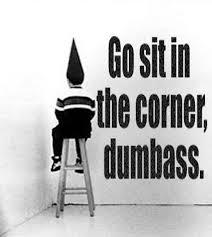
Despite my agreement and support of Edgetivism I don't consider myself an Edgetivist for two interconnected reasons. First, it's a fact that some artists use art to further an ideological agenda. In that sense, the distinction between art and the real world becomes blurred as the artist wants his work to have a concrete effect (For more on this issue see my post Punching Nazis, Black Metal, and the Use of Ideological Symbols. ) In this way, the artist moves away from authentic art as a medium of self-exploration and catharsis. Secondly, the same problem occurs in connection to Edgetivism itself. It too is militant art. And that's why I'm not an Edgetivist. My writing does have an edgy character but that's incidental. The essential thing is the inner struggle and tension it comes out of. Chaoscunt claims, "Always produce works that side against the predominant people in the art world. Make anti-Christian and feminist art in middle-age Europe, make anti-Islamic and anti-feminist art in 2016 Europe." I personally have nothing against feminism and I hate Islam as I hate all religions. But neither of these issues has penetrated my sphere of artistic interest and anything I'd write about them would appear phoned in and inauthentic. On the other hand, anti-capitalism is a notion close to my heart, the alienation, exploitation, and degradation of the individual that are intrinsic to this economic system fill me with monstrous rage. And this is something I tackle in my novella 'Ich Will'. My point is that there's a gap between what is edgy in an authentic work of art and what may be considered edgy and taboo in a certain society at a given time. No doubt there's a lot of overlap between the two but a true artist can't just mechanically follow what others find taboo and then force himself to make art against it. Instead, he should courageously face his fears and inner demons, and that confrontation is bound to have some edgy and disturbing aspects, but that's a natural side-effect and not the main goal of the artist.
All in all, I salute Edgetivism as an authentic movement in a mass of artistic conformity. Saftyism requires relentless mockery and opposition as it leads to grotesque organizations like Antifa, and the rise of censorship and artistic repression, troglodytes judging beautiful works of art, a totalitarian nightmare. I
Published on December 08, 2019 08:22
November 25, 2019
Satanism Declawed (The Satanic Temple abomination)
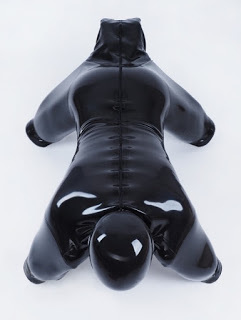 Ecce Homo, according to TST, the perfect subI was pretty enthusiastic about the Satanic Temple (TST, for short) when I saw the documentary "Hail Satan?" I was so into it I wanted to join the Edmonton chapter, but I soon realized it was a sad gathering of soy losers. Looking back, I think my infatuation had to do with my bitter hatred against the fascist Evangelical movement in the US. I figured that the enemies of my enemy must be my friends. Plus, I fully support the leftist politics behind the Satanic Temple, and their fight for equality, social justice, and LGBTQ rights. But soon I realized there's something rotten about TST, and it has to do with their hijacking and banalization of noble Satanic symbols and traditions, with no regard to their spiritual significance.
Ecce Homo, according to TST, the perfect subI was pretty enthusiastic about the Satanic Temple (TST, for short) when I saw the documentary "Hail Satan?" I was so into it I wanted to join the Edmonton chapter, but I soon realized it was a sad gathering of soy losers. Looking back, I think my infatuation had to do with my bitter hatred against the fascist Evangelical movement in the US. I figured that the enemies of my enemy must be my friends. Plus, I fully support the leftist politics behind the Satanic Temple, and their fight for equality, social justice, and LGBTQ rights. But soon I realized there's something rotten about TST, and it has to do with their hijacking and banalization of noble Satanic symbols and traditions, with no regard to their spiritual significance. TST reeks like a public toilet or the sour sweatness that infuses a crowded bus. Its members are animated by the fearful hysteria of special needs kids singing around a campfire, hoping to keep the monsters away. There's nothing Satanic about this movement. The central, traditional Satanic virtues are aristocratic pride, uncompromising individualism, colossal arrogance, elitism, sadism, a glorification of war and strife, and a romantic, creative outlook on life coupled with a delight in solitude. Now, the first tenant of TST reads: "One should strive to act with compassion and empathy toward all creatures in accordance to reason." A true Satanist would recoil in disgust at this. If you squint a bit, behind that tenant, you can see the defeated, grotesque figure of the perennial slave, the marginalized loser, the creature born with the sole task of tasting all flavors of pain. And that resentful slave is the exact opposite of what traditional Satanism is all about. In fact, that pitiful slave is precisely the Christian scum which has been the whip boy of the true Satanist throughout the ages. The repugnant slave is now hiding under the guise of his master. What a farce! What a bad joke! One can't help but wonder, how did this sad transformation come about? In what follows I describe a few factors that must have contributed to this absurd state of affairs.
It is well-known that the fascist Evangelical right in the US has nothing to do with real Christianity. Following their Protestant outlook, the right-wing Christians hate the poor and equate poverty with sin, while success and wealth are seen as a blessing. Now, gradually this so-called Christian entity started to take on some seemingly Satanic attributes: strict hierarchal social order, intolerance, arrogance and disdain for the weak and vulgar. If you want, it started taking on the attributes of the Ancient Roman ruling class, the class that had been the target of the early Christians. Now, with this analogy in mind, the rise of TST is starting to make sense. Under the veneer of Satanism, the logical opposite of evil Christians, the old Christianity is reformed. The cries for equality, justice and inclusion are heard again. But this is just socialism with a Satanic face. Satanism is in no way essential to this movement. It is a paradigmatic Christian movement. Very edifying in this respect are Nietzsche's remarks about the Christian roots of socialism. One of them reads: “The socialists appeal to the Christian instincts; that is their most subtle piece of shrewdness” (Will to Power)
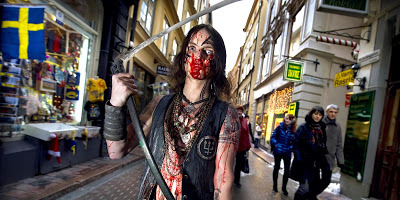 Watain, one of the black metal bands carrying the banner of true Satanism
Watain, one of the black metal bands carrying the banner of true SatanismAlthough a ruling political class can exhibit virtues associated with Satanism, Satanism in and of itself is strictly apolitical. By definition, the Satanist values his private space, his solitude, the realm where his authentic freedom can blossom. Others are usually a hindrance. The fun begins when the noises of the herd die down. Following Aristotle, Nietzsche reminds us: "To live alone one must be either a beast or a god." And self-deification is something the Satanist strives for. By contrast, any political enterprise starts with the question of the common good, of an optimal organization of society. Now, any such endeavor, by definition, would make the Satanist vomit, as he knows his own good is not the good of the crowd. Those two values are incommensurable because of the unbridgeable gap separating him from the vulgar slave. To put it differently, the Satanist strives to be a monster or a god, he wants to transcend his own humanity. Being human is a limit to be overcome in the spiritual quest for freedom. Now, any political project hinges on the premise of our common humanity, that we're all more or less the same, a homogeneous mass, we have all the same pains, the same hopes, and aspirations, the same things that make us happy. For the Satanic beast, this postulated uniformity is pure blasphemy and should be rejected in all its shapes and forms.
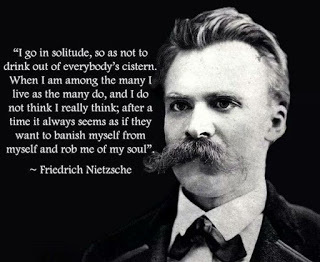
And this is why there's no strict contradiction between being a true Satanist and a leftist, though surely there's a psychological tension between the two. These two commitments belong to different spheres. One is private and the other is public. In the public sphere, one's humanity is assumed and one fights for the common good of all humans. In the private sphere, humanity and its limitations are questioned, man challenges the idea that he's a creation and becomes himself a creator. This is why creativity, originality and a strong artistic impulse define the authentic Satanist. He doesn't bow down to whatever values happen to exist in the degenerate community he contingently inhabits, but he creates his own values. For more on this issue, see my posts Punching Nazis, Black Metal, and the use of Ideological Symbols and my review of Berdyaev's Slavery and Freedom .
In conclusion, TST is a repugnant abomination, mixing Satanism with political activism, cheapening noble Satanic symbols with their vulgar practices thus obscuring their original spiritual meaning and power. The herd instinct of these weaklings to organize and form chapters and nests around the world is completely foreign to the Satanic spirit. I think it would be more honest and honorable for this movement to just be a political leftist movement and just drop the "Satanic" gimmicks. But honor and honesty are hard to expect from slaves who constantly use deception for attention and survival.
Published on November 25, 2019 12:17
November 23, 2019
Interview about Odin Rising
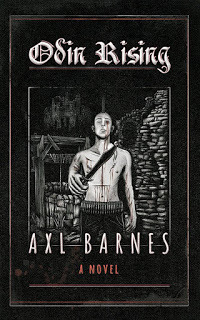
Here's a recent interview I did with a local author about my new novel.
What inspired your latest novel?
It was inspired by my rebellious adolescence, my first encounter with extreme metal, heavy drinking, and the radical philosophies of nihilism and Satanism. Adults are always quick to judge teens as naive or reckless, but I wanted to explore an intolerant teen's judgment of adulthood as a realm of weakness, slavery, and decay.
How did you come up with the title?
Carl Gustav Jung wrote a famous essay "Wotan" in 1936, where he explains Hitler's rise to power in terms of the awakening of Wotan (Odin), the god of war, in the collective unconscious of the German people. The title is used ironically, as Tudor, Alex, and Edi—the trio of anti-social teens I follow in the book—think they too are under the martial spell of the Norse God.
Is there a message in your novel that you want readers to grasp?
I enjoy blurring the distinction between life and death and uncovering what philosopher Emil Cioran calls "death's imminence in life." That is, that being alive is just a form of being dead; that we're nothing but complex zombies, mechanical systems that function based on a multitude of algorithms designed by a blind evolutionary process. And this is the sinister side of Tudor's insight that Satanism is necrophilia: the rebellious, satanic impulse to transcend the monotony of ordinary life is a paradoxical impulse that denies itself as it's annihilated by that which it negates. In other words, absolute freedom is nothingness, or a void that lies outside our language.
How much of the book is realistic?
Most of it is realistic, except the last three chapters in which I use a few dream-sequences and finally, in the last chapter, the distinction between dream and reality is completely eliminated.
Are your characters based on someone you know, or events in your own life?
Yeah, they are mostly based on my friends from high school.
Where can readers find you on social media and do you have a blog?
facebook.com/AxeBarnes/; twitter.com/axlbarnes I'm also on Goodreads.
Do you have plans or ideas for your next book? Is it a sequel or a stand-alone?
My next novel is called This Town Must Burn and it grows naturally out of Odin Rising but it's not a sequel. It will be a more extreme horror novel, influenced by Edward Lee, Bryan Smith, and Tim Miller.
Of the characters you have created or envisioned, which is your favorite, and why?
I love them all, but especially Tudor Negur as he has the courage to follow the self-destructive consequences of his beliefs.
Do you favor one type of genre or do you dabble in more than one?
I like the sub-genre of psychological horror as most of my characters are mentally disturbed in some way, mostly by being psychopaths. But there's also a lot of philosophy in my writing, so it fits the label of philosophical fiction as well. I like my monsters to be inquisitive, lucid, and intellectually challenging for the reader.
Do you plan your stories, or are you a seat of the pants style writer?
George A. Martin draws the distinction between "two types of writers, the architects and the gardeners. The architects plan everything ahead of time, like an architect building a house [...] The gardeners dig a hole, drop in a seed and water it." I'm a gardener, I plant the seed of a story, I water it with my sleep, my boredom, and my loneliness, and hope it would grow into something true and beautiful.
What is your best marketing tip?
I'm just getting a handle on marketing and have no tips so far.
Do you find social media a great tool or a hindrance?
A great tool.
What age did you start writing stories/poems?
16. I started out with poetry and then short stories.
What genre are you currently reading?
I'm reading The Fireman by Joe Hill, so horror/dark fantasy.
If you could meet one favorite author, who would it be and why?
Stephen King. He's my #1 influence when it comes to fiction writing and also an amazing human being.
Do you see writing as a career?
No, I dislike the term "career." Too ideologically loaded. It links art to commercial success and entertainment value and cheapens it. I see art as an expression of spiritual freedom, as something good in itself, something connected with our deepest nature as beings contemplating mystery and searching for revelation.
Published on November 23, 2019 08:41

